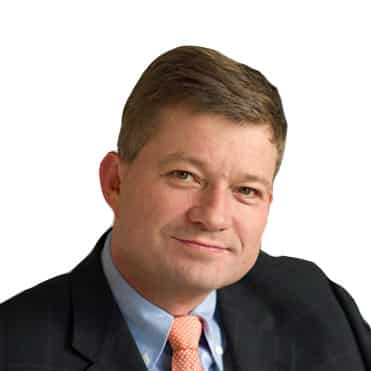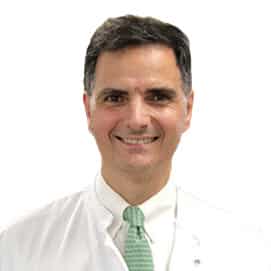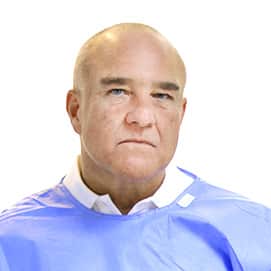When the diagnosis of prostate cancer is confirmed and the extent and stage of the disease are determined, the doctor agrees with the patient which treatment options will be used.
The following methods are offered for the treatment of prostate cancer in German clinics:
- Operation
- Radiation therapy
- Hormone treatment
- Chemotherapy
- Active Surveillance
For tumors limited to the prostate (early stage), prostate cancer treatment in Germany is offered with surgery or radiation therapy. Surgery means the removal of the prostate. The main goal is to completely remove the tumor tissue and thereby achieve recovery. Radiation therapy can be an alternative to surgery. Its use is considered especially in cases where surgery cannot be performed due to the general condition of the body or the advanced age of the patient, or if the patient refuses to undergo surgery.
If by the time of diagnosis the tumor has already spread to neighboring tissues and has metastasized to the lymph nodes (advanced stage), then surgery or radiation as a single therapy is not enough. In this case, in addition or in continuation, such forms of treatment are prescribed that act not only on the prostate, but on the whole body (hormone therapy).
If the tumor has already formed metastases in the bones, then the treatment of prostate cancer in Germany in our clinics is carried out using hormonal and chemotherapy, as well as targeted radiation therapy to combat the pain caused by metastases. The goal is to stop the spread of the tumor and preserve the patient's quality of life. Recovery at this point is no longer possible.
Active Surveillance
Prostate carcinoma is one of those types of cancer that often grow slowly and do not pose an immediate danger to those who are ill. For patients over 75 years of age or for patients with small and low malignant tumors, it is possible to initially not have prostate cancer treatment in Germany and see if the tumor grows at all. If it is determined that the tumor is growing, then treatment is immediately prescribed. This active surveillance strategy includes regular PSA measurements, prostate palpation, and prostate tissue sampling (biopsy). With the progression of the tumor, appropriate treatment is prescribed.
Operation
In cases where the cancer is limited to the prostate gland, it can be eliminated by surgical removal of the prostate; if this succeeds completely, then one speaks of R0 - resections. The removal of the prostate is called a radical prostatectomy. At the same time, the seminal vesicles are removed and, depending on the risks, the pelvic lymph nodes. This is done to prevent the spread of tumor cells through the lymphatics. Removed lymph nodes are examined microscopically, thus it is possible to establish how far the disease has spread and what further treatment is needed. After removal of the prostate, the urethra is reconnected to the bladder so that emptying of the bladder is possible in a normal way.
The chances of a long recovery if the tumor is confined to the prostate are very good. The further the tumor has gone, the less the possibility R0 - resections and, thus, less likely to achieve tumor relief with the help of surgery. Despite the introduction of improved surgical techniques in recent years, it is impossible to completely avoid the undesirable consequences of radical removal of the prostate, such as loss of the ability to have an erection (impotence) and involuntary urination (urinary incontinence). Transient urinary incontinence is relatively common. As a rule, it takes several weeks or months until the function of urinary retention at the urethral sphincter is fully restored. With the help of targeted exercises, the so-called pelvic floor muscle training, long-term urinary incontinence can be successfully counteracted. Approximately 5 - 10% operated patients have urinary incontinence.
Restriction or loss of the ability to have an erection (impotence) is due to the fact that when the prostate is removed, the nerve pathways responsible for erection are damaged. Nerve pathways run left and right along the prostate. Depending on how far the cancer has spread, it may be possible to save one or both of the nerve bundles during the operation. Potency can be maintained in half to two-thirds of patients, depending on their age.
Radiation therapy
During irradiation, radioactive radiation is aimed directly at the tumor. Thus, the nuclei of the cancer cells are so severely damaged that the cancer cells can no longer divide and die. There are 2 different types of radiation. One is carried out from the outside, the so-called percutaneous (percutaneous) radiation therapy, the other is from the inside, the so-called brachytherapy.
Transcutaneous radiotherapy
For locally advanced prostate carcinoma, irradiation of the tumor area from the outside is suitable as the first therapy according to scientific guidelines. Exposure must be three-dimensionally planned. First, accurate pictures of the prostate are obtained with the help of computed tomography. With their help, you can accurately determine the area in which the total dose of radiation should fall. The surrounding healthy tissue, on the contrary, should be spared as much as possible and irradiated as little as possible. After calculations, the irradiation is directed from many directions exactly to the tumor. The total radiation dose should be at least 72 Gy, and the patient receives it in single sessions of radiation for 7 to 9 weeks on weekdays. Increasing the dose gives, on the one hand, better treatment results, but, on the other hand, causes more severe side effects. For locally advanced prostate cancer, scientific guidelines recommend supporting radiation exposure with hormonal therapy. It should be started 2-3 months before percutaneous radiotherapy and continued for at least 2, and preferably 3 years.
Brachytherapy
As an alternative to external radiation, a radiation source can be placed directly on the tumor. This radiation from a short distance is called brachytherapy. In this case, 2 methods are distinguished: Seed-implantation (LDR-brachytherapy) and afterloding (Afterloading) (HDR- brachytherapy).
At Seed- implantation of the smallest sources of short radiation, the so-called Seedsare injected into the prostate. Accommodation Seeds is carried out using a puncture needle under ultrasound control and in purposefully selected places. The radioactive radiation emitted Seedsdestroys cancer cells from within. Accommodation Seeds lasts about 2 hours and is performed under light general anesthesia or spinal anesthesia. For early stage prostate cancer, brachytherapy works just as well as external radiation. Important: Seed-implantation according to new scientific guidelines is not recommended for local advanced prostate carcinoma or in the presence of metastases.
In afterloding, a source of radioactive radiation is placed for a short time through a hollow needle into the prostate, and it thus destroys the tumor cells. This form of therapy is combined with external radiation.
In some patients, radiation therapy is given as an additional measure after surgery (adjuvant therapy). This should reduce the risk of relapse. In addition, irradiation is often used for targeted control of metastases. If recovery from a tumor disease is no longer possible, a significant reduction in pain can be achieved.
Hormone suppression therapy
In advanced stages, when the tumor can no longer be removed or destroyed by surgery or radiation, or when distant metastases have already formed, hormone-suppressing therapy is the treatment of choice for prostate cancer in Germany.
The main goal of hormone suppression therapy is to suppress the production or action of the male sex hormone testosterone, as it stimulates the growth of prostate tumors. In most cases, with the help of antihormonal treatment, tumor growth is stopped for some time, often for years.
There are 2 types of hormone suppression therapy:
- Suppression of the production of the male sex hormone testosterone.
- Blocking the effect of testosterone on tumor cells with the help of so-called antiandrogens.
Hormone suppression therapy can be given as long-term therapy or at intervals (intermittent therapy).
Suppression of testosterone production
The treatment of prostate cancer in Germany by turning off the production of testosterone is carried out in two ways: the surgical removal of hormone-producing tissue, namely the testicles, or medication. The advantage of the operation (orchiectomy) is that it is a one-time event. But it finds little acceptance among patients, is irreversible (compared to intermittent therapy), and is therefore rarely performed at present. With drug suppression of testosterone production, 2 groups of active substances are distinguished: substances of hormonal action and thus indirectly suppressing testosterone production (LHRH luteinizing hormone releasing hormone analogues or also GnRH gonadotropin-releasing hormone agonists); as well as substances that have an antagonistic effect and thereby directly give a signal to suppress the production of testosterone (GnRH gonadotropin-releasing hormone antagonists).
Suppression of testosterone production LHRH - analogues:
LHRH-analogues are similar in structure to a hormone LHRH (luteinizing hormone releasing hormone). This hormone is released by the hypothalamus (part of the brain) and plays a role in signaling for testosterone production in the testicles. LHRH-analogs initially cause a similar cascade of signals, but due to "long-term stimulation" they eventually lead to blockade of testosterone production. Possible side effects include hot flashes and sweating, but these can be managed well with medication. Patients should be aware that during the period of treatment there is a decrease in sexual desire and impotence. It also increases the risk of diabetes and decreases bone density (osteoporosis).
Suppression of testosterone production GnRH -antagonists:
GnRH stands for gonadotropin-releasing hormone and has the same meaning as LHRH. Unlike LHRH-analogues GnRH-antagonists interrupt the signal transmission path from the hypothalamus to the sex glands by blocking the pituitary gland receptors. This results in an immediate suppression of testosterone production. Side effects at GnRH-antagonists are the same as those GnRH-agonists.
Antiandrogens inhibit the action of testosterone by blocking testosterone receptors in tumor cells. Under certain conditions, they are appointed in addition to LHRH-analogues ("maximum androgen blockade") for the complete protection of cancer from hormones that stimulate its growth, which, despite therapy, are still present in small quantities. In some cases, only antiandrogens are prescribed first, as an alternative LHRH-analogues due to fewer side effects.
Intermittent therapy
For advanced tumors, the treatment of prostate cancer in Germany with hormones is a long-term therapy, which means that it is carried out for as long as it lasts. You can also try the so-called intermittent therapy. With it, the phases of treatment lasting for months are replaced by intervals free from therapy. On the one hand, the emergence of hormone-insensitive cancer cells should be slowed down in this way. In the phases without treatment, the side effects of the absence of the hormone partially disappear, and the body recovers, which may be associated with the return of potency and an improvement in the quality of life. However, reliable long-term data on intermittent therapy do not yet exist, therefore, in current scientific recommendations, the treatment of prostate cancer in Germany with the use of this therapy, although admitted to practice, is not strongly recommended. After some time of hormone-suppressing therapy, tumor cells develop that can grow independently of the hormone. To control the tumor, antihormonal therapy alone is no longer enough, and the next step in treatment, chemotherapy, may be necessary.
Chemotherapy
During chemotherapy, medicines are prescribed, so-called cytostatics, which inhibit the growth of cancer cells and thereby destroy cancer cells. Cytostatics are usually administered intravenously. They are distributed throughout the body and reach tumor cells that have already spread to other areas of the body. This therapy does not bring recovery, but it can significantly slow down the course of the disease.
Treatment of bone metastases
Advanced prostate carcinoma often creates daughter tumors (metastases) in the bones. They can cause severe pain. In addition, they affect the bones in such a way that it can easily lead to fractures. As a rule, the risk of fracture can be prevented by irradiation of bone metastases: the bones become hard again. Also, by giving certain radioactive substances that accumulate in diseased bones and irradiate them from the inside, it is possible to achieve the reverse development of bone tumors (radionuclide therapy). Both techniques are an effective way to deal with pain. In addition, the administration of substances that inhibit bone destruction (bisphosphonates, such as zoledronic acid) may reduce the risk of complications arising from bone metastases and reduce pain. Also, combined radiation/bisphosphonate therapy can reduce pain caused by bone metastases.
Head of the Clinic of Oncology, Hematology and Palliative Medicine
Head of the Clinic for General, Visceral, Thoracic and Endocrine Surgery
Head of the Clinic for Radiation Therapy and Radiological Oncology
Video
Request appointment
Useful links
Photo gallery












